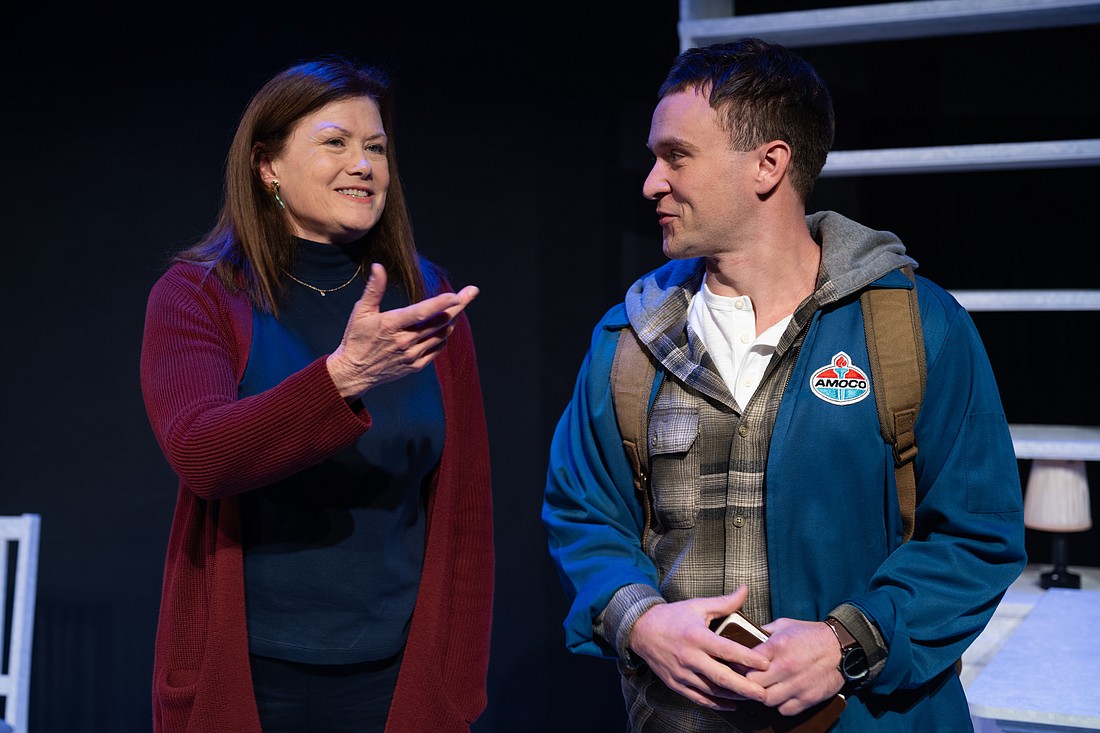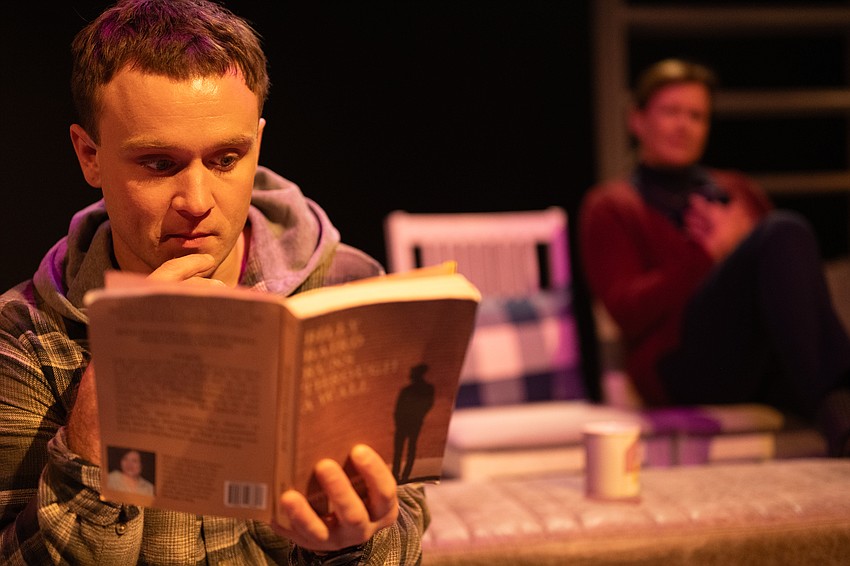- July 26, 2024
-
-
Loading

Loading

Adam Rapp’s “The Sound Inside” is now reverberating at Urbanite Theatre. It’s a bloody brilliant play — and that’s not hyperbole. What’s the story? Uhh … That simple question defies simple answer. Let’s just call it a story about storytellers. That’s a gross oversimplification, but it’s all I’ve got.
Rapp’s tale begins in the office of Bella Lee Baird (Vickie Daignault), a writing professor at Yale. Speaking directly to the audience, she literally tells the tale.
After briefly introducing herself, Bella spins a yarn about Christopher Dunn (Evan Stevens), a student in her freshman creative writing class. Chris just might be a literary diamond in the rough. He might also have a Charlie Manson twinkle in his eye. The professor lists various warning signs …
The kid’s got talent. He’s also got problems. Chris has a short fuse. The wrong word choice might trigger his manic rant. Look at him cross-eyed and he’ll spit on your floor. Raskolnikov, the thrill-killer of Dostoevsky’s “Crime and Punishment,” is the lad’s favorite character.
Why is Bella telling her student’s story? Because Chris told it to her.
One fine day, this oddball auteur gives the professor a surprise visit. No warning. Chris just barges into Bella’s office and reads her the first few pages of his novella-in-progress.
It’s the tale of another Chris. His fictional doppelganger might be scheming to kill a stranger — or he might not. The budding author doesn’t know where his story’s going yet. The professor doesn’t know what to make of Chris. He’s impressed her. But fear still crawls up Bella’s spine.
Chris’ nascent novella is a ripping yarn with great prose style. But is it fact or fiction? Bella’s been telling her students to “write what they know.” This apt pupil might have applied that lesson. Which means …
Chris could be a killer. That stone-cold fear is clear, but never clearly stated. Rapp drops it in the soup in the first 15 minutes. The student’s iffy ultraviolence is only one fearful ingredient. The playwright stirs the pot with many others. These include a bad news X-ray and a heart-wrenching favor the professor asks her student. (And that’s as specific as I’ll get.)

This play’s scary recipe is pure Stephen King. The playwright’s technique takes a post-modern page from David Foster Wallace. (And maybe Wes Anderson.) Simply put, Rapp’s make-believe is undisguised.
“The Sound Inside” is fiction. Rapp knows that. He assumes you do, too. And the play doesn’t try to hide its fictional artifice.
The playwright’s naked make-believe violates the first commandment of storytelling: “Show, don’t tell.” That’s in every fiction-writing Bible. (As I recall, it was one of Ann Beattie’s rules in her short story class.) It’s not one of Rapp’s rules.
“The Sound Inside” shows and tells you — at the same time! When Bella begins Chris’s tale, the character appears on stage. She describes Chris. The actor’s actions exactly match her description — in perfect synch. (You can fact-check Bella’s words by glancing at Stevens’ performance.) Neat trick. But the double vision gets under your skin.
Director Kristin Clippard never loses balance on Rapp’s wobbly meta-fictional tightrope. She keeps you guessing about what’ll happen next. You never doubt what’s happening now. Clippard directs with crystal clarity. With Rapp’s mind games to work with, that’s a high-wire act.
Rapp’s fictional Fantasia exists in a disassociated bubble universe in this Urbanite production. Kristy Iris’s realistic costumes play off Tom Hansen’s minimalistic set. Rew Tippin’s sound design and compositions and Alex Pinchin’s lighting softly whisper hints of dread.
Fear is the key in “The Sound Inside.” Suspense is a constant background radiation in this production. But it stays in the background. The two actors never overplay the fear factor.
Stevens’s Chris is creepy-charming. He’s either a sociopath — or a dangerous visionary who knows how sociopaths think. Despite these grim alternatives, his character’s still likable. (To be fair, Charlie Manson was too, at times.)
Daignault smartly conveys Bella’s “How did I get here?” astonishment. In her youth, she was a promising novelist with great reviews. She’s now middle-aged and living a life of quiet desperation … with tenure. Those problems are merely external. Bella’s internal problems are far worse. Loneliness is the problem both characters share. They’re writers, after all. Rapp is, too.
Despite that job description, the playwright scorns Anton Chekhov’s holiest fiction-writing rule. (“A shotgun above the fireplace in the first act should be fired in the second,” to roughly paraphrase.)
Rapp snaps that edict in half like a cheap No. Two pencil. “The Sound Inside” is an arsenal of unfired Chekhovian shotguns.
You say you want a resolution? You won’t get it.
As noted, the playwright keeps the pot boiling with scary set-ups. Stephen King would pay them off with satisfying punch-lines. (I would too, in my own clumsy fashion.) Rapp doesn’t. No soup for you, folks.
“The Sound Inside” portends fearful apotheosis. But Rapp withholds any wrap-up. His play’s only fatality happens off-stage; his fictional dream ends with words, not gore. Many terrifying questions remain unanswered. There may be resolution. But only after Rapp’s elliptical play ends.
That sounds like a bait-and-switch. But it isn’t.
“The Sound Inside” may be packed with suspense. But it isn’t a detective story, horror story, or a Lifetime TV movie. At heart, the play’s a character study. Of two storytellers and how they think.
Getting inside Chris and Bella’s writerly heads is the real payoff. And Rapp gets it right. The inside baseball; the in-group lingo; the petty college politics; the ambitions; the jealousies; the insecurities; the name-dropping. It all rings true.
In the world according to Rapp, devotion to the unforgiving art of storytelling is part of the writer’s life. Isolation is, too.
Putting dreams on paper is a schizoid chore — and a lonely one. Any halfway decent fiction writer can say, “Mankind is my business.” But that business demands distance. You’re an eavesdropper on your friends’ conversations. Always recording, observing, remembering. Always one step removed.
Writers will know what I’m talking about. They’ll definitely relate to Rapp’s story. Will non-writers give a flying fandango?
Good question. Which brings us to Ann Beattie’s No. 1 rule …
“Don’t write about writers. Write about plumbers, air traffic controllers, cocktail waitresses, welders, accountants, or anyone else. But don’t write about writers, OK? And for God’s sake don’t write about writers struggling to write. Nobody cares.”
Stephen King broke that rule and got away with it in “The Shining.” Rapp does, too, in “The Sound Inside.”
You might not be a writer. You might hate writing worse than public speaking. You might actually hate writers. All that may be true. Even so, you’ll care about the writers in this play.